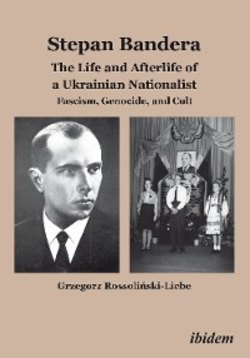Читать книгу Stepan Bandera: The Life and Afterlife of a Ukrainian Fascist - Grzegorz Rossoliński-Liebe - Страница 19
Objectives and Limitations
ОглавлениеThis book investigates Bandera’s life and cult. It concentrates on Bandera’s political, and not his private life. It pays attention to Bandera’s thoughts and his worldview, which can be reconstructed from books and newspapers that he read, published, or edited, opinions that he held and that he expressed in public, as well as the combat and propagandist activities that he organized or participated in. The history of the OUN and UPA takes up a substantial part of the study, in order to provide important background knowledge. The form of this book is determined by the major questions, the long period covered by the narrative, and the methods applied. It thereby differs from studies that ponder the advantages and disadvantages of nationalism or socialism for the life of a nation, or that explore short-term processes such as collaboration in a particular region or country during the Second World War.
The book is written “against the grain” in order to uncover several covered-up, forgotten, ignored, or obfuscated aspects of Ukrainian and other national histories. Obviously, the study does not seek to exonerate the Germans, Soviets, Poles, or any other nation or group for the atrocities committed by them during or after the Second World War but it cannot present and does not pretend to present all relevant aspects in an entirely comprehensive way. It pays more attention to subjects such as the ethnic and political violence of the OUN and UPA than it does to German or Soviet occupation policies in Ukraine. This method of presenting history is determined by the main subject of this study, which is Bandera and his role in the Ukrainian ultranationalist movement. Parts of the book may therefore evoke the impression that the major Holocaust perpetrators in western Ukraine were the Ukrainian nationalists and not the occupying Germans and the Ukrainian police. It is not the aim of this study to argue this. This study makes clear estimates of the percentages of people who were killed by the Germans and the Ukrainian police on the one hand, and by the OUN and UPA and other Ukrainian perpetrators on the other.
It is not the aim of this book to argue that all eastern Galician and Volhynian Ukrainians (and logically not all Ukrainians) supported the politics of the OUN, fought in the UPA, were involved in the Holocaust, the ethnic cleansing against Polish population, and other forms of ethnic and political violence conducted by the OUN and UPA, or that they agreed with such actions. The study explores the interrelation between nationalism and the violence committed in its name, but it does not ignore the economic, social, and political factors that contributed to ethnic conflicts or to the formation of fascist movements.
This monograph does not negate the fact that, during the Second World War, Ukrainians were both victims and perpetrators, and that the same persons who were involved in ethnic and political violence became the victims of the Soviet regime. Moreover, the study does not suggest that all Ukrainians who were in the OUN or UPA were fascists or radical nationalists. There were different reasons for joining the OUN and UPA, and various kinds of people joined these organizations, some of them under coercion. Logically, the study does not imply that all Ukrainians who joined the OUN or UPA committed atrocities, or that among Ukrainians, only OUN and UPA members were involved in the Holocaust or other atrocities. Such an assumption would distort reality, and exonerate groups such as non-nationalist Ukrainians, the Ukrainian police, and Ukrainians who participated primarily for economic and other non-political reasons. Finally, Ukrainian political parties and organizations other than the OUN appear only marginally in this study, because the monograph concentrates on Bandera and the OUN. As a result, readers might receive the impression that the OUN was the organization that dominated the entire political life of Ukraine. This, of course, is not true. Many other nationalist, democratic, conservative, and communist organizations and parties existed in Ukraine before the Second World War, and also impacted political life there, but they are not the subject of this book.
